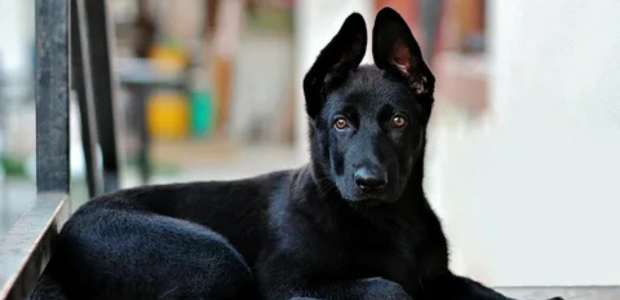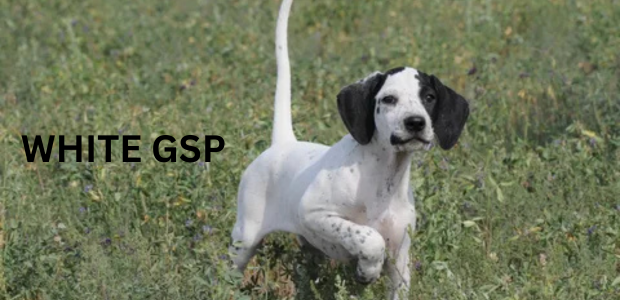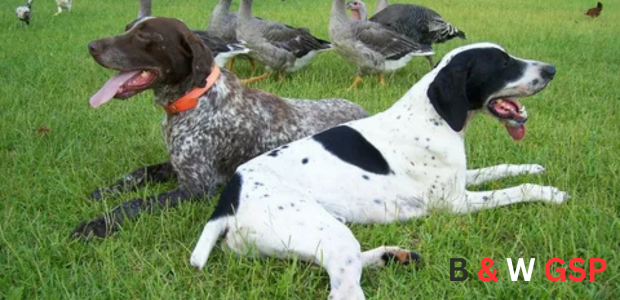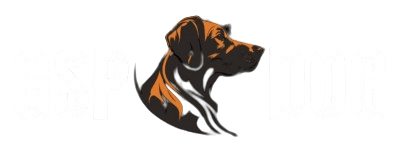Introduction
Black and white German shorthairs training is very important for every family who have a black and white gsp.It’s a great journey to bring a Black and White German Shorthairs into your home. These canines, who are well-known for being gregarious and energetic, are wonderful friends. They need to be trained to be polite family members, just like any other breed. Training involves more than just teaching; it also involves developing a relationship based on mutual respect and understanding. You may teach your German Shorthair to be a devoted and compliant pet using the correct method. This article will give you the crucial knowledge and methods you need to effectively educate your Black and White German Shorthair, ensuring a happy and peaceful coexistence.
Table of Contents
Sorting Out the Particularly Isolating Behavior of German Shorthairs

You should determine the attitude of your German Shorthair before you start displaying it. These dogs are incredible in their zeal, energy, and grabbing. Because of their high degree of social contact, they might attract both humans and other animals. Given that it is losing the chance to complete, this breed can have a more straightforward layout. In any case, their high levels of energy necessitate real enthusiasm and healthy brain functions. If they don’t improve, they may get tired and start acting out. By understanding these traits, you can modify your arrangement structures to pinpoint your dog’s problems.
Crucial Methods for Training German Shorthairs
When getting your high contrast German Shorthair ready, it’s important to use techniques for positive reinforcement. Accordingly, you can reward your dog with treats, praise, or extended playtime when he behaves nicely. Start with the most important instructions, including “sit,” “remain,” and “come.” After practicing these commands for short periods of time, logically increase their complexity as your dog gains knowledge. Be dependable and always use similar language and signals to avoid mistakes. In the unlikely event that it is entertaining and captivating to set up meetings, your dog will be more convinced and eager to learn. In the end, this will result in a thorough comprehension and reaction to your instructions.
Establishing a Routine for Training Your Black and White German Shorthairs

Creating a training routine is essential for effective learning. Try to train your Black and White German Shorthairs at the same time every day because dogs love routine and structure. Sessions that last between 10 and 15 minutes are more beneficial than those that are longer and less frequent. To assist your dog concentrate, pick a peaceful area free from distractions. Lessons can be reinforced by integrating training into regular activities, such as playing or walks. Maintaining a schedule can help your German Shorthair become accustomed to training, which will make it easier and more pleasurable for both of you.
Positive reinforcement is the key to successful training.
Among the best training techniques is positive reinforcement. This approach emphasizes rewarding your dog for desired behaviors rather than punishing them for misbehaving. For instance, give your Black and White German Shorthairs a treat and some praise right away if it sits on command. Your dog will better grasp the behavior you want to see more of as a result of this relationship. Learning is reinforced when positive behavior is consistently rewarded. Keep in mind that patience is key; if your dog doesn’t react immediately away, give them some time. You and your German Shorthair will appreciate training more if you establish a connection of trust.
Socialization Tips for Your Black and White German Shorthairs
Socialization is a critical part of training. It facilitates your Black and White German Shorthairs adjustment to various settings, humans, and other animals. Introduce your puppy to a variety of settings early on, including as parks, crowded streets, and family get-togethers. Reward calm conduct by introducing them to new people and pets gradually. Having a good socialization experience will help your dog become a well-mannered adult. Frequent encounters will also help people avoid becoming afraid or aggressive in new settings later in life. Keep in mind that the objective is to develop a kind and self-assured partner
Normal Preparation Difficulties and How to Defeat Them

Training can sometimes come with challenges. Black and White German Shorthairs may display stubbornness or distractions during sessions. Walk away and try again later if your dog is not reacting. Maintaining enjoyable and captivating sessions is also crucial; altering the setting or the activity might spark their interest again. Divide a command into manageable chunks if your dog has trouble with it. Be patient and consistent, reinforcing each step along the way. With persistence and understanding, you can overcome these challenges and help your dog succeed in their training.
Exercises to Keep Your German Shorthair Engaged
Physical exercise is essential for a Black and White German Shorthair. Regular activity not only keeps them healthy but also helps with their training. Get your dog involved in a variety of activities, such as swimming, agility classes, or fetch. These activities keep you from getting bored and stimulate your mind. By incorporating training instructions into fun, you can keep your dog occupied and promote learning. Think about enrolling in agility or obedience-focused lessons or joining a dog sports group. In addition to keeping your dog content and well-behaved, these activities can improve your relationship.
Maintaining Consistency in Training Sessions
Consistency is crucial in training your Black and White German Shorthair. To prevent confusion, make sure that everyone in the family uses the same commands and incentives. This cohesive strategy makes expectations easier for your dog to understand. Keep training sessions short and regular, as dogs learn better with frequent practice. If your dog successfully follows a command, be sure to reward them consistently. Their comprehension is strengthened by this reaffirmation. Your dog will eventually learn to obey commands consistently, which will improve your quality of life together.
Advice for House Training Your Black and White German Shorthairs
One of the first difficulties faced by new dog owners is house training. Take your Black and White German Shorthair outside often, especially after meals and naps, and start by teaching them a regular toilet pattern. Use a specific spot in your yard for bathroom breaks to create an association. When your dog goes outside, reward them immediately. Be patient and refrain from reprimanding others because accidents will happen. Instead, clean up messes without fuss, and continue to reinforce good behavior outdoors. With consistency and patience, your German Shorthair will learn to signal when they need to go out.
How to Effectively Use Commands with Your German Shorthair

Effective command use can have a significant impact on your Black and White German Shorthairs training. Begin by giving your dog easy-to-understand, straightforward commands. Don’t use more than one command for the same task, and speak in a forceful yet kind manner. This clarity speeds up your dog’s learning. Create a visual indication by combining hand signals with spoken instructions. To be sure your dog can respond to commands in a variety of situations and distractions, practice them. Your dog will become a well-trained companion if you practice often and teach him to link commands to actions.
Conclusion
By using these methods and advice, you may successfully teach your Black and White German Shorthairs, creating a close relationship and guaranteeing a contented, well-mannered companion.
FAQs
1. How much time does it take to teach a black and white German shorthairs?
The length of training varies according on the age and experience level of the dog. In general, you should start to notice improvement after a few weeks of steady practice. It could require a couple of months to learn fundamental orders.
2. What age is ideal for beginning training?
The best time to begin teaching your Black and White German Shorthairs is when it is 8 to 12 weeks old. A strong foundation for future learning is established by early socialization and fundamental instruction.
3. How easy is it to train German Shorthairs that are black and white?
Indeed, they are renowned for their intelligence and desire to please, which makes them very simple to.
4. Which training techniques work best?
The most effective way to prepare German Shorthairs is to utilize uplifting feedback. They are more likely to repeat positive conduct when it is rewarded with toys, praise, or playing.
5. How much exercise is necessary for them?
Due to their high levels of energy, Black and White German Shorthairs need to exercise for at least one to two hours every day. Frequent exercise keeps them well-behaved and intellectually engaged.
6. How can I prevent jumping in my German Shorthair?
Teach your dog the “sit” command to deter jumping. Before introducing yourself to guests or while playing, practice this instruction. Reward them for remaining seated rather than bouncing up.
7. If my dog isn’t obeying my directions, what should I do?
Make sure you’re using clear orders and look for distractions if your dog isn’t responding. Try shorter sessions, take breaks, and always acknowledge and celebrate any success, no matter how tiny.
8. Can a German Shorthair be trained at home?
Of course! Training at home can be quite successful. Simply have a regular routine, eliminate distractions, and employ positive reinforcement strategies.
9. How should my German Shorthair be socialized?
Gradually expose your dog to different situations, people, and other animals. To encourage composure during these exchanges, use positive reinforcement.



